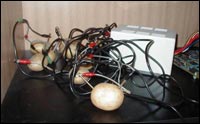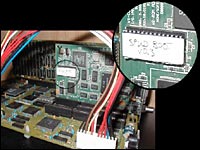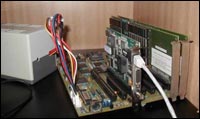
|
| About 12 potatoes can be used to power a computer |
A group of UK computer gurus have created what they believe to be the first potato-powered web server. The twentysomething techies who run a website called Temple ov thee Lemur, have gone a step beyond the elementary school science experiments that use potatoes to power everything from light bulbs to digital clocks.
The group has done other quirky projects that involved finding new uses for old computer parts. But their newest spud server creation (that also uses old computer parts) was developed because of other motives. "We were in the pub talking about it and someone said we couldn't possibly do it," says Chris Gutteridge, who manages the Internet site. "We said, 'yes we can', and now they're looking very embarrassed."
Gutteridge says one of the hardest parts of the project was finding the used parts. But after about a week, they were able to work out how to design the spud server and conclude whether their vision was possible. Another challenge involved harnessing the potato's limited power potential (half a volt of power per potato) to run the server.

|
| Close-up of memory boards |
Potatoes produce power by acting like a car battery (or an electrolyte). The power of a 'potato battery' comes from the electro-chemical reaction that occurs when zinc and copper electrodes are attached to the vegetable. The potato does not participate directly in the reaction, but the salty sap of the potato reacts with the metals in a chemical process and produces electrical energy.
The group created the spud server by stripping an Intel 386 computer of everything except its central chip and integral circuitry. In order to conserve more power, the computer's hard disk was replaced by a custom-built chip with pre-installed server software and two web pages. The group's experiment proves that once the fans, the floppy and hard disk drives are removed, a computer can be powered by about 12 potatoes, which are replaced every few days.
Gutteridge says their spud server has very basic capabilities. And to prevent a crash, only a few people can browse the web pages on the spud server at a given time.

|
| Low power 386 motherboards |
"Although it's very minimal - technically it can be described as a web server," says Gutteridge. "You can actually connect to it and see the main page that says hello and you can see how long it has been up for. You're supposed to be able to see the time but the computer is second hand and that's broken. And the computer's date says 1970 - but this wasn't exactly done on a high budget."
Although the potato power project was mainly sparked by a cocky bar room bet, Gutteridge and friends are already thinking about future plans. "We have an idea but we don't think it's going to work," says Gutteridge. "We were discussing trying to do [a server] with a hamster wheel but we don't think that it would give out enough power."
For more information on the spud server see the Temple ov thee Lemur's website.
For more information on the brains behind the creation see the creators' website.
|